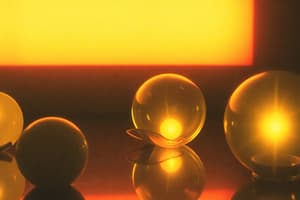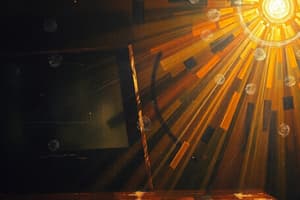Podcast
Questions and Answers
What defines a luminous body?
What defines a luminous body?
- An object that reflects light from another source
- An object that can only be seen in the dark
- An object that emits light by itself (correct)
- An object that receives light but does not emit it
What happens to a non-luminous body when light from a luminous body falls on it?
What happens to a non-luminous body when light from a luminous body falls on it?
- It reflects the light and becomes visible (correct)
- It becomes invisible
- It absorbs all the light and does not reflect
- It generates its own light
Which of the following is an artificial source of light?
Which of the following is an artificial source of light?
- An electric bulb (correct)
- Stars
- The Sun
- The Moon
How does light travel in terms of direction?
How does light travel in terms of direction?
Which property of light explains its ability to travel through a vacuum?
Which property of light explains its ability to travel through a vacuum?
What is the effect of mist on the visibility of beams of light?
What is the effect of mist on the visibility of beams of light?
What is the primary source of energy for nearly all life on Earth?
What is the primary source of energy for nearly all life on Earth?
According to the properties of light, what happens as light waves move away from a source?
According to the properties of light, what happens as light waves move away from a source?
Which statement best describes the Moon in relation to light?
Which statement best describes the Moon in relation to light?
What is necessary for an object to be visible to the human eye?
What is necessary for an object to be visible to the human eye?
What is a key property of a ray of light as it travels through different mediums?
What is a key property of a ray of light as it travels through different mediums?
What happens to light as it moves past the edge of an object?
What happens to light as it moves past the edge of an object?
Which of the following is NOT a color in white light?
Which of the following is NOT a color in white light?
What defines the angle of incidence?
What defines the angle of incidence?
What is observed when light is reflected from the mirror?
What is observed when light is reflected from the mirror?
Which statement is true regarding the energy of the reflected ray compared to the incident ray?
Which statement is true regarding the energy of the reflected ray compared to the incident ray?
Which of these laws states that the angle of incidence is equal to the angle of reflection?
Which of these laws states that the angle of incidence is equal to the angle of reflection?
What will light not do unless disturbed or it travels through a different medium?
What will light not do unless disturbed or it travels through a different medium?
The point where the incident ray strikes a mirror is known as what?
The point where the incident ray strikes a mirror is known as what?
What will cause a light wave to decrease in intensity?
What will cause a light wave to decrease in intensity?
What is the primary characteristic of a virtual image formed by a plane mirror?
What is the primary characteristic of a virtual image formed by a plane mirror?
How is a real image different from a virtual image?
How is a real image different from a virtual image?
What occurs during regular reflection?
What occurs during regular reflection?
Which of the following statements about the image formed by a plane mirror is correct?
Which of the following statements about the image formed by a plane mirror is correct?
What defines an object as a 'point object'?
What defines an object as a 'point object'?
What happens during diffuse reflection?
What happens during diffuse reflection?
Which of the following is NOT a property of the image formed by a plane mirror?
Which of the following is NOT a property of the image formed by a plane mirror?
Which type of object reflects light due to its inherent properties?
Which type of object reflects light due to its inherent properties?
What is primarily responsible for the image being laterally inverted in a plane mirror?
What is primarily responsible for the image being laterally inverted in a plane mirror?
What material is commonly used to produce house-hold mirrors?
What material is commonly used to produce house-hold mirrors?
Flashcards
Luminous Object
Luminous Object
An object that produces its own light.
Non-luminous Object
Non-luminous Object
An object that doesn't produce its own light, but reflects light.
Rectilinear Propagation
Rectilinear Propagation
Light travels in straight lines.
Light source
Light source
Signup and view all the flashcards
Light waves
Light waves
Signup and view all the flashcards
Light energy
Light energy
Signup and view all the flashcards
Visible light
Visible light
Signup and view all the flashcards
Natural Light source
Natural Light source
Signup and view all the flashcards
Artificial Light source
Artificial Light source
Signup and view all the flashcards
Light rays
Light rays
Signup and view all the flashcards
Light's Path
Light's Path
Signup and view all the flashcards
Diffraction
Diffraction
Signup and view all the flashcards
Speed of Light
Speed of Light
Signup and view all the flashcards
White Light
White Light
Signup and view all the flashcards
Light Intensity
Light Intensity
Signup and view all the flashcards
Reflection
Reflection
Signup and view all the flashcards
Incident Ray
Incident Ray
Signup and view all the flashcards
Angle of Reflection
Angle of Reflection
Signup and view all the flashcards
Laws of Reflection
Laws of Reflection
Signup and view all the flashcards
Plane Mirror
Plane Mirror
Signup and view all the flashcards
Reflected ray
Reflected ray
Signup and view all the flashcards
Real image
Real image
Signup and view all the flashcards
Virtual image
Virtual image
Signup and view all the flashcards
Regular reflection
Regular reflection
Signup and view all the flashcards
Diffuse reflection
Diffuse reflection
Signup and view all the flashcards
Image
Image
Signup and view all the flashcards
Point object
Point object
Signup and view all the flashcards
Study Notes
Light
- Light and sound are how we experience the world
- Light is needed to see
- Plants use light energy to create food
- Light from the sun powers most of Earth's energy and warmth
- Understanding light and why things are visible took a long time.
Luminous and Non-Luminous Objects
- Luminous Objects: Emit light on their own
- Examples: Sun, stars, light bulbs, lanterns, fluorescent tubes, candles
- Non-Luminous Objects: Do not produce light
- Visible only when light from a luminous source hits them and is reflected
- Example: Moon (reflects sunlight)
Opaque, Transparent, and Translucent Objects
-
Opaque: Does not allow light to pass through.
- Light is either absorbed or reflected
- Example: Steel tumbler
-
Transparent: Allows light to pass through easily
- Very little light is absorbed or reflected
- Example: Glass tumbler
-
Translucent: Allows some light to pass through, but scatters it
- Difficult to see clearly what's behind a translucent object
- Example: Tinted/milky glass tumbler
Rectilinear Propagation of Light
- Light travels in straight lines
- Common observations supporting this concept, including shadows, eclipses, and light beams
- Light travels through a vacuum and does not change direction unless the medium changes
Properties of Light
- Light is a form of energy, traveling as waves
- Light spreads outwards in all directions from a source
- Light can travel through empty space (a vacuum) without needing a medium (solid, liquid, gas) to move through
- Light rays always travel in straight lines
- The speed of light in a vacuum is approximately 300,000 km/s (3 x 10⁸ m/s)
- Light has different colours (violet, indigo, blue, green, yellow, orange, red) that combine to create white light.
- Light has different intensities (brightness)
Reflection of Light
- Light bounces off surfaces. This is called reflection
- The angle of incidence equals the angle of reflection
- Laws of reflection apply to all types of waves
- Reflection can be regular (smooth surfaces) or diffuse (rough surfaces)
Studying That Suits You
Use AI to generate personalized quizzes and flashcards to suit your learning preferences.




